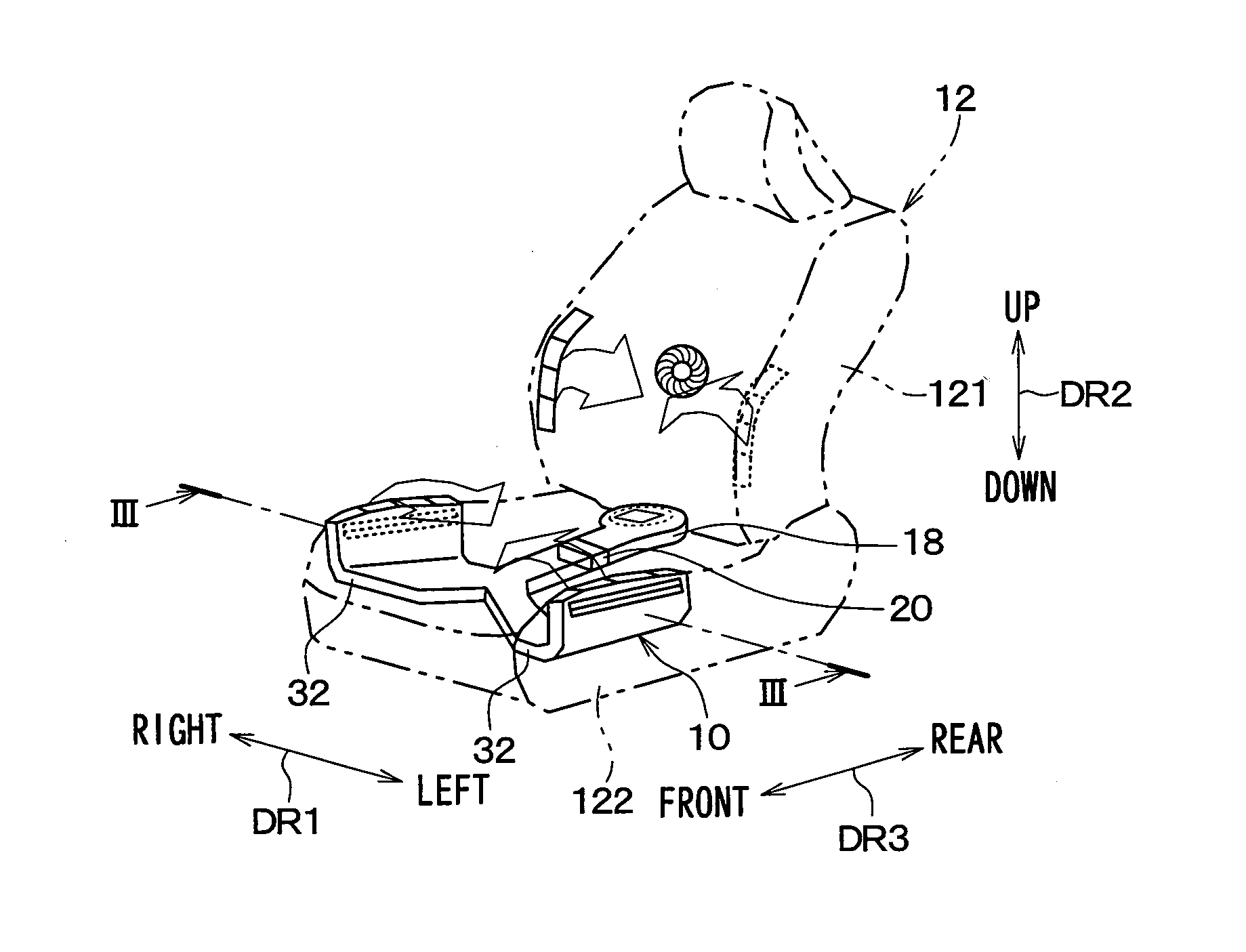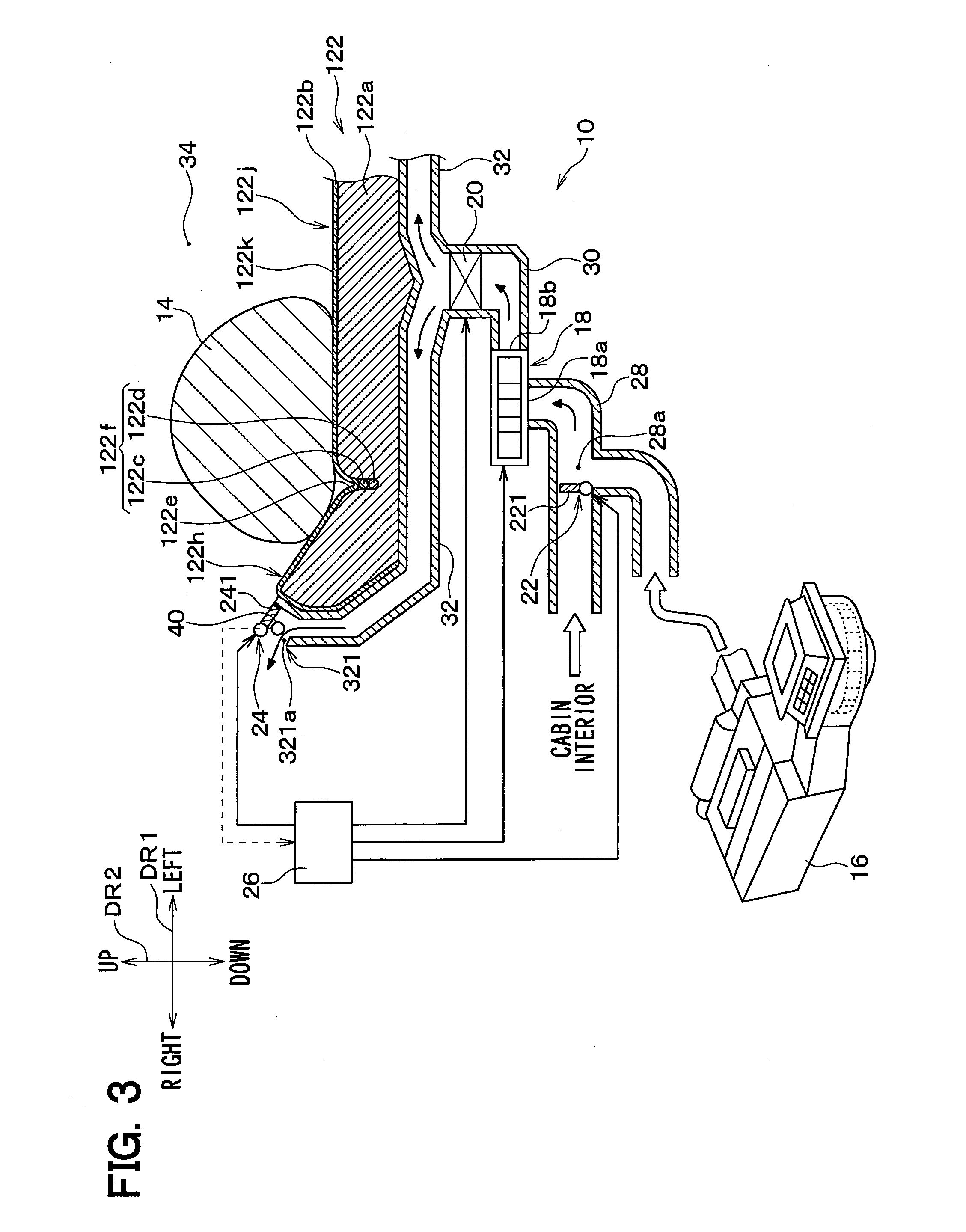Vehicle seat air-conditioner
a technology for vehicle seats and air conditioners, which is applied in vehicle heating/cooling devices, seat heating/ventilation devices, vehicle arrangements, etc., can solve the problems of large heat loss, passenger sitting on the vehicle seat, and so as to avoid blowing insufficiently temperature controlled air
- Summary
- Abstract
- Description
- Claims
- Application Information
AI Technical Summary
Benefits of technology
Problems solved by technology
Method used
Image
Examples
first embodiment
[0030]FIG. 1 is an outline perspective view showing a vehicle seat air-conditioner 10 of the present embodiment, and showing a vehicle seat 12 having the vehicle seat air-conditioner 10 installed. Each of a seat back 121 and a seat cushion 122 of the vehicle seat 12 has a vehicle seat air-conditioner installed. The vehicle seat air-conditioner 10 of the present disclosure (hereinafter, simply “seat air-conditioner 10”) is a vehicle seat air-conditioner installed in the seat cushion 122. Further, in FIG. 1, the directional market DR1 shows a left-right direction DR1 of the vehicle, i.e., is a vehicle width direction DR1. The directional market DR2 shows an up-down direction DR2 of the vehicle, i.e., is a vehicle vertical direction DR2. The directional market DR3 shows a front-rear direction of the vehicle, i.e., is a vehicle longitudinal direction DR3
[0031]The vehicle seat 12 shown in FIG. 1 includes the seat back 121 and the seat cushion 122. A passenger sitting on the vehicle seat ...
second embodiment
[0060]Next, a second embodiment of the present disclosure will be explained. The explanation will be focused on the points of the present embodiment which differ from the previously described first embodiment. Further, explanations of portions which are the same as, or equal to, the previous embodiment will be omitted or simplified. The same applies the third embodiment and onward, described later.
[0061]FIG. 6 is a cross sectional view of the seat air-conditioner 10 and the seat cushion 122 of the present embodiment, and corresponds to FIG. 3 of the first embodiment. FIG. 7 is a cross sectional view of the seat air-conditioner 10 and the seat cushion 122 of the present embodiment, and corresponds to FIG. 4 of the first embodiment. FIG. 7 is different from FIG. 6 in that the orientation of an air guide member 242 of the blowout air switching device 24 is different.
[0062]As shown in FIGS. 6 and 7, the blowout ventilation pipe 32 of the present embodiment does not wrap around the sides...
third embodiment
[0067]Next, a third embodiment of the present disclosure will be explained. The explanation will be focused on the points of the present embodiment which differ from the previously described first embodiment.
[0068]FIG. 8 is a cross sectional view of the seat air-conditioner 10 and the seat cushion 122 of the present embodiment, and corresponds to FIG. 3 of the first embodiment. FIG. 9 is a cross sectional view of the seat air-conditioner 10 and the seat cushion 122 of the present embodiment, and corresponds to FIG. 4 of the first embodiment. FIG. 8 is different from FIG. 9 in that the orientation of an opening and closing door 243 of the blowout air switching device 24 is different.
[0069]As shown in FIGS. 8 and 9, the blowout ventilation pipe 32 of the present embodiment does not wrap around the sides of the seat cushion 122, and the blowout ventilation pipe 32 does not have the air blowout portion 321 (refer to FIG. 3). An end portion 322 of the blowout ventilation pipe 32, which i...
PUM
 Login to View More
Login to View More Abstract
Description
Claims
Application Information
 Login to View More
Login to View More - R&D
- Intellectual Property
- Life Sciences
- Materials
- Tech Scout
- Unparalleled Data Quality
- Higher Quality Content
- 60% Fewer Hallucinations
Browse by: Latest US Patents, China's latest patents, Technical Efficacy Thesaurus, Application Domain, Technology Topic, Popular Technical Reports.
© 2025 PatSnap. All rights reserved.Legal|Privacy policy|Modern Slavery Act Transparency Statement|Sitemap|About US| Contact US: help@patsnap.com



